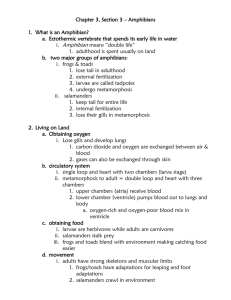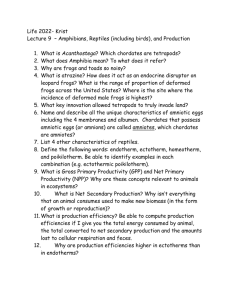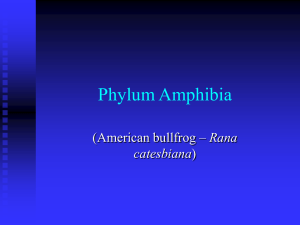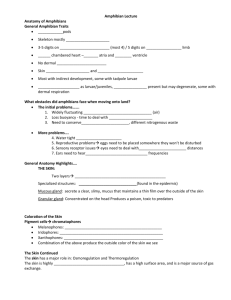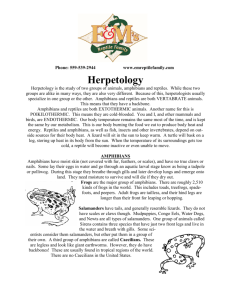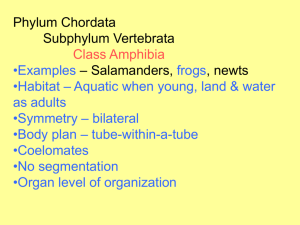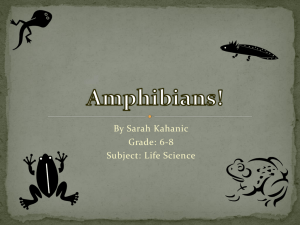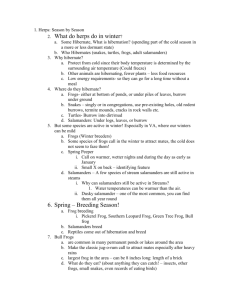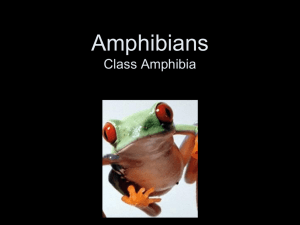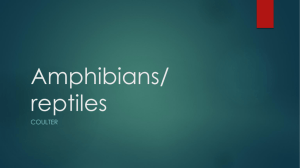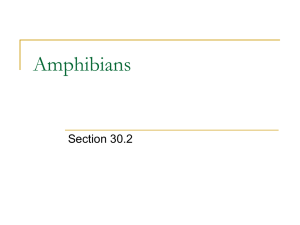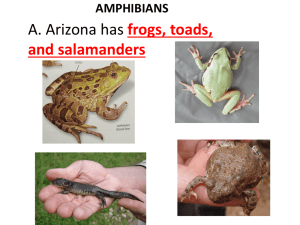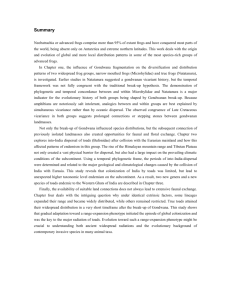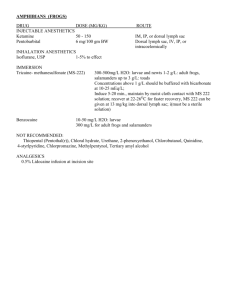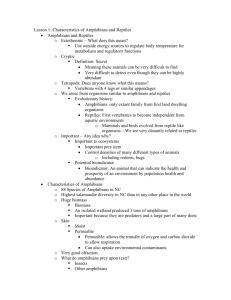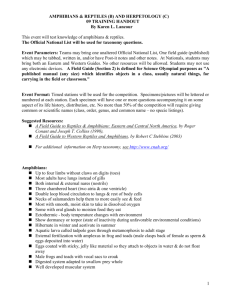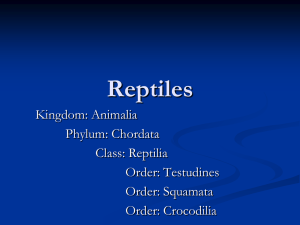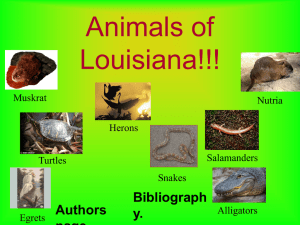Amphibians and Reptiles
advertisement
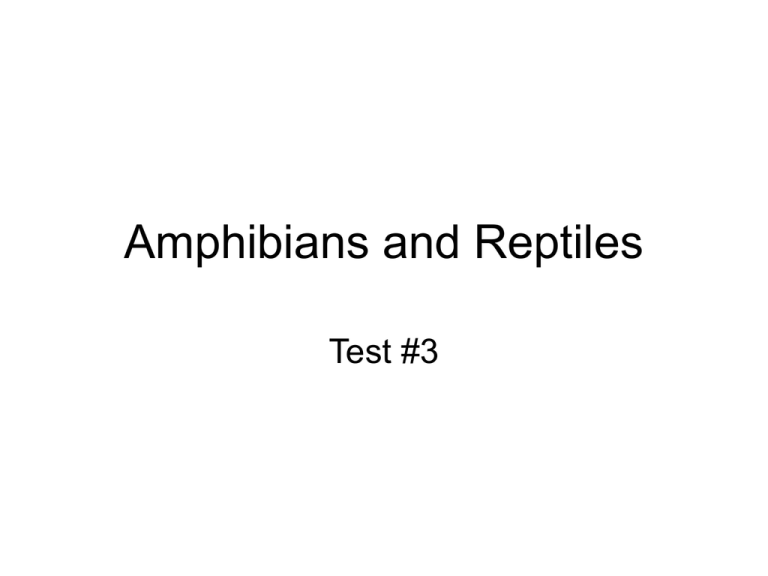
Amphibians and Reptiles Test #3 Class: Amphibia • First vertebrates on land were in Class Amphibia • Amphibian-means “two lives” • About 4,000 species of frogs, salamanders, and caecilians (limbless animals that burrow in tropical forests and fresh water lakes) Devonian Time Period – Cycles of drought and then heavy rainfall then drought again – Lobe-finned fish were at an advantage because the bones in their fins are like that in the arms and legs of early amphibians – They were able to come to land to escape predators or to get food. 3 Orders of Amphibians • 1. Urodela – “tailed ones” – salamanders • 2. Anura – “tail-less ones” – frogs & toads • 3. Apoda – “leg-less ones” – caecilians Order: Urodela (Salamanders) • 400 species • Some are entirely aquatic and some live on land • Most walk by bending their body from side to side Order: Anura (Frogs and Toads) • • • • 3,500 species More specialized for living on land Use strong legs to hop Flick tongue to catch insect What is the difference between frogs and toads? • Frogs are in the family Ranidae and have the following characteristics: – Bulging eyes – Webbed feet and longer legs for swimming – Smooth or slimy skin – Lay eggs in clusters Toads • Toads are in the family Bufonidae and have the following characteristics: – Stubby bodies with short hind legs for walking instead of hopping – Warty dry skin – Poison glands behind the eyes – Lay eggs in chains Defense from predators • Camouflage • Secrete mucous that is bad tasting or poisonous • Many with poison have a bright color to warn predators Order: Apoda (Caecilians) • Legless • Nearly blind • Look like earthworms Amphibian Characteristics • • • • • Frogs Tadpole --------------------------Adult Aquatic with gills Gills & tail disappear Lateral line Lateral line Finned tail Develops legs Frogs – Frogs have air breathing lungs, eardrums, and a digestive system (carnivorous diet) – Some frogs do not go through the tadpole phase – Some are strictly aquatic and some are strictly land – Salamanders and caecilians resemble adults when born – Even land-dwelling amphibians need a moist habitat – Some breathe through skin and mouth b/c they have no lungs Frogs – Eggs do not have a shell and dehydrate in air – Male causes female to release eggs and spills sperm while she does this – Some incubate eggs on back, mouth, or in stomach – Some are ovivaporons (eggs hatch in uterus) and viviparons (young develop in uterus) • Social life – Frogs are usually quiet, but many call during mating season • Many want to protect territory or attract females Class: Reptilia • 7,000 species • Many extinct species • Mainly lizards, snakes, turtles, and crocodilians • Birds are closely related Reptile Characteristics • Scales create waterproof skin – (Helps prevent dehydration in air) • Have lungs because they can’t breathe through moist skin • Some turtles have gas exchange through their moist cloaca • Most lay shelled eggs on land • Internal fertilization Reptile Characteristics • Called “cold-blooded” or ectothermic because they don’t use their metabolism to control their body temperature • they regulate their temperature in other ways • Ectotherms body temperature changes with their surroundings Extinct Reptiles • • • • 1. Dinosaurs lived on land different sizes up to 45 m long 2. Pterosaurs flying reptiles wings were a membrane of skin stretched from the body wall to the tip of an elongated finger • many were very fast • social and give parental care Modern Reptiles • • • • 3 Largest Orders 1. Chelonia (turtles) 2. Squamata (lizards and snakes) 3. Crocodilia (crocodiles and alligators) Order: Chelonia • Have not changed much since the Mesozoic era • What is the difference between a turtle and a tortoise? – Turtles are any reptile that lives in a shell. – A tortoise is a turtle that lives on land but enters the water for various reasons. Order: Squamata • Lizards- most numerous and diverse • May have survived cold by nesting in crevices to maintain heat Order: Squamata • Snakes- descendants of lizards that adopted a burrowing lifestyle – Today, most snakes live above ground – Boa’s have vestigial pelvic and limb bones (primitive snakes) – Snakes are carnivorous – They have chemical sensors on their tongue that helps them detect prey – have no ear drums – feel vibrations on the ground – they have heat detecting organs between the eyes and nostrils – they inject poison through hollow teeth – They have loose jaws that help swallow prey Crocodilians (crocodiles and alligators) • Largest living reptiles • Spend most of their time in water breathing through upturned nostrils • Live in warmer areas • Most closely related to dinosaurs of all the reptiles • Birds are the closest relatives to reptiles What is the difference between a crocodile and an alligator? • Crocodile: – Has a long V shaped snout – Upper and lower jaws are the same width so teeth show interlocking when mouth is shut What is the difference between a crocodile and an alligator? • Alligator: – Wide U shaped snout – Have a wider upper jaw so that the teeth from the upper portion only show when the mouth is closed.
